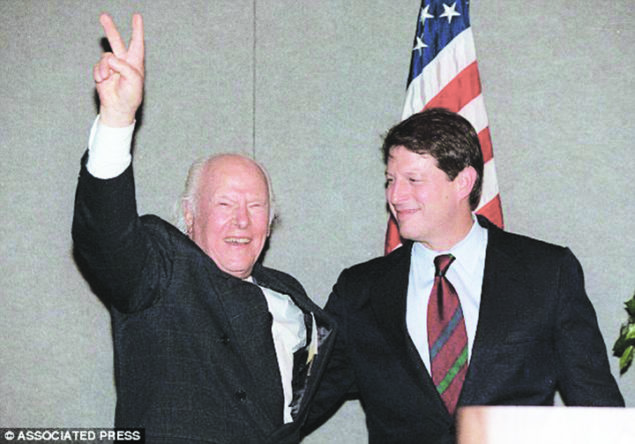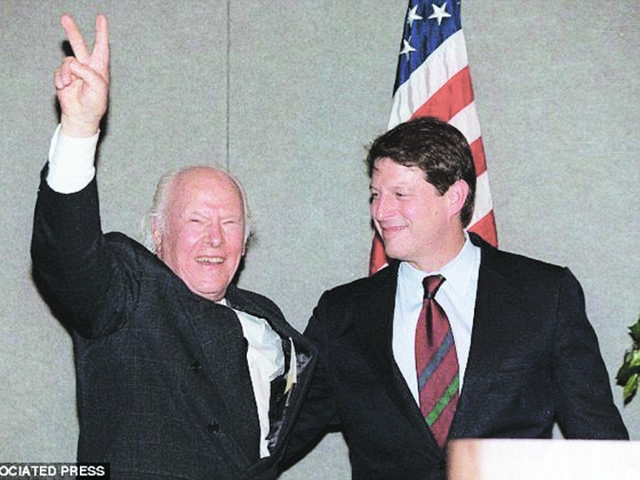
When Democrats here caucused to decide their support for the 1988 presidential nomination, the gathering took place at the home of Kendall Coffey, then President of the South Dade Democratic Club and later the U.S. Attorney for South Florida.
Approximately 40 activists met at Kendall’s Pinecrest home and one of them had a very, personal interest in how the vote would go that night. His son Al Gore, a young senator, was one of the candidates for president.
The caucus had been underway for 20 minutes when I spotted this older, distinguished looking gentleman entering the home. It was the first Senator Gore, a hero to those who followed politics closely; he was one of three Southern senators who refused to sign The Southern Manifesto, a segregation-inspired proposal offered by Sen. Strom Thurmond — infamous for his racial politics. Gore’s actual words to Thurmond were “Hell no” when he was asked to sign.
I left the caucus huddle and introduced myself to Mr. Gore. He remarked to his aide, “It looks like everyone here is for Dukakis.” But what I wanted to hear from Sen. Gore was about the time he almost made history more than 30 years earlier.
Radio was to bring us together that August day in 1956. My brother and I were driving to a baseball game that night in Cincinnati, Ohio. The Reds – then known as the Redlegs – were playing the first place Milwaukee Braves.
When we got to the outskirts of Columbus Dick turned on the radio just as a major political brawl was erupting at the Democratic National Convention. The party had again chosen Gov. Adlai Stevenson as the presidential nominee to oppose President Eisenhower. However, Stevenson decided not to name his choice for vice president and threw the process open to the delegates.
The new VP candidates had but one day to campaign among the delegates convening in Chicago. The Chairman of the Tennessee delegation, Senator Estes Kefauver, had sought the presidential nomination twice, but lost both times to Stevenson. As a courtesy, Sen. Gore went to his colleague.
“I would like to run for vice president, but I’ll stand aside if you’re interested.”
Kefauver, who had gained renown for the Kefauver Crime Commission, told Gore he was not interested in making the race. Gore started campaigning and found he had some support among the delegates. The distinguished field of candidates included our own Governor Leroy Collins, Sen. Hubert Humphrey, Mayor Robert Wagner of New York City, and a little known 39 year old freshman senator from Massachusetts John F. Kennedy.
Gore’s vote total got to almost 200, but more than 600 were needed to win the nomination. Kennedy led the early voting and at one point was within 15 votes of a majority.
“That’s when Kefauver jumped into the race,” Gore recalled.
The radio account of the VP contest was expertly reported by CBS News Correspondent George Herman.
Vote trading, vote switching and smoke filled rooms made up the milieu that hot afternoon. But in the end, the delegates gave the majority of their votes to the experienced, popular Kefauver with Kennedy finishing a close second. In the Fall the Democratic ticket suffered a second landslide loss to President Eisenhower and the Republicans.
The senior Senator Gore passed away in 1998. And, as we all know, his son’s presidential fate was decided in Florida a month after the 2000 election when 537 votes prevented him from winning the state and being elected president.
Bob Goldstein is a retired broadcaster who has lived in South Florida for more than forty years. He is a veteran political activist (dsdcfl.org) and a member of the South Florida Writers Association. If you’d like to comment on Bob’s columns, send your response by email to robertgrimm62@yahoo.com.






